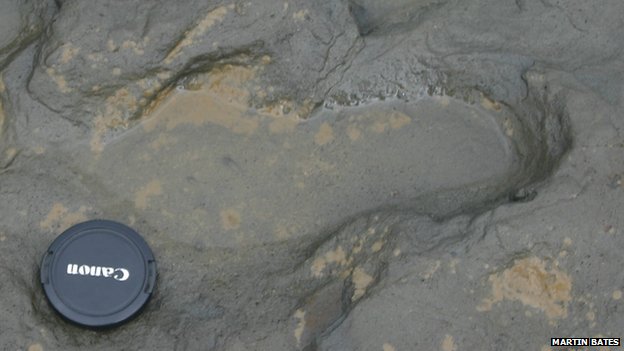
|
Scientists have discovered the earliest evidence of human footprints outside of Africa, on the Norfolk Coast in the East of England. The footprints are more than 800,000 years old and were found on the shores of Happisburgh. They are direct evidence of the earliest known humans in northern Europe. Details of the extraordinary markings have been published in the science journal Plos One. The footprints have been described as "one of the most important discoveries, if not the most important discovery that has been made on [Britain's] shores," by Dr Nick Ashton of the British Museum. "It will rewrite our understanding of the early human occupation of Britain and indeed of Europe," he told BBC News. The markings were first indentified in May last year during a low tide. Rough seas had eroded the sandy beach to reveal a series of elongated hollows. I walked with Dr Ashton along the shore where the discovery was made. He recalled how he and a colleague stumbled across the hollows: "At the time, I wondered 'could these really be the case? If it was the case, these could be the earliest footprints outside Africa and that would be absolutely incredible." Such discoveries are very rare. The Happisburgh footprints are the only ones of this age in Europe and there are only three other sets that are older, all of which are in Africa. "At first, we weren't sure what we were seeing," Dr Ashton told me, "but it was soon clear that the hollows resembled human footprints." The hollows were washed away not long after they were identified. The team were, however, able to capture the footprints on video that will be shown at an exhibition at London's Natural History Museum later this month. The video shows the researchers on their hands and knees in cold, driving rain, engaged in a race against time to record the hollows. Dr Ashton recalls how they scooped out rainwater from the footprints so that they could be photographed. "But the rain was filling the hollows as quickly as we could empty them," he told me. The team took a 3D scan of the footprints over the following two weeks. A detailed analysis of these images by Dr Isabelle De Groote of Liverpool John Moores University confirmed that the hollows were indeed human footprints, possibly of five people, one adult male and some children. Dr De Groote said she could make out the heel, arch and even toes in some of the prints, the largest of which would have filled a UK shoe size 8 (European size 42; American size 9) . "When I was told about the footprints, I was absolutely stunned," Dr De Groote told BBC News. "They appear to have been made by one adult male who was about 5ft 9in (175cm) tall and the shortest was about 3ft. The other larger footprints could come from young adult males or have been left by females. The glimpse of the past that we are seeing is that we have a family group moving together across the landscape." It is unclear who these humans were. One suggestion is that they were a species called Homo antecessor, which was known to have lived in southern Europe. It is thought that these people could have made their way to what is now Norfolk across a strip of land that connected the UK to the rest of Europe a million years ago. They would have disappeared around 800,000 years ago because of a much colder climate setting in not long after the footprints were made. It was not until 500,000 years ago that a species called Homo heidelbergensis lived in the UK. It is thought that these people evolved into early Neanderthals some 400,000 years ago. The Neanderthals then lived in Britain intermittently until about 40,000 years ago - a time that coincided with the arrival of our species, Homo sapiens. There are no fossils of antecessor in Happisburgh, but the circumstantial evidence of their presence is getting stronger by the day. In 2010, the same research team discovered the stone tools used by such people. And the discovery of the footprints now all but confirms that humans were in Britain nearly a million years ago, according to Prof Chris Stringer of the Natural History Museum, who is also involved in the research at Happisburgh. "This discovery gives us even more concrete evidence that there were people there," he told BBC News. "We can now start to look at a group of people and their everyday activities. And if we keep looking, we will find even more evidence of them, hopefully even human fossils. That would be my dream".
|
據英國廣播公司2月7日報道,科學家在英格蘭東部黑斯堡海岸上發現80多萬年前的人類腳印遺跡,這是非洲之外最古老的人類腳印遺跡,直接證明歐洲北部早期人類的存在。 來自英國國家博物館的迪克?阿什頓博士和同事們在2013年5月發現這些腳印。當時海水沖刷,帶走海灘上的沙子,腳印遺跡暴露在外。阿什頓當時想:“這怎么可能是真的呢?如果真的是這樣,它們就是歐洲以外最古老的腳印了,真讓人難以置信。” 類似發現極其罕見,全世界最古老的3處人類腳印遺跡都在非洲。論年代,本次發現排名第4。 阿什頓說:“剛開始我們不知道這是什么,但很快就發現這些坑洞很像人類腳印。”不久之后,。研究人員趕在腳印被海浪沖刷殆盡之前拍下了視頻,并且將在倫敦自然歷史博物館展播。視頻中,研究人員冒著雨、爭分奪秒地從腳印中舀出雨水,方便拍攝。 發現腳印后的2周里,研究人員對腳印進行了3D掃描。伊莎貝爾?德格羅特博士仔細分析后認定,它們的確是人類腳印,還說能還原包括腳跟、足弓和腳趾在內的部分腳部模型。這些腳印來自一名成年男子、幾個孩子、以及另外5個人。男子身高約為1.75米,最矮的兒童有0.91米左右。其中最大的一只腳今天能穿42號鞋。德格羅特認為這可能是一家人在趕路。 腳印主人的身份目前還是個謎。有人猜測他們可能是早前住在歐洲南部的先驅人(Homo antecessor),大約100萬年前遷徙而來,但是無法忍受寒冷的氣候,在80萬年前消亡。科學家還沒有在黑斯堡地區發現先驅人的化石,但曾在2010年發現他們的石制工具。自然歷史博物館的克里斯?斯特林格教授對未來充滿希望,他說:“本次發現帶來更多切實證據證明,這里曾經有過人類……如果我們繼續尋找,就能找到更多證據,甚至人類化石也有可能。” 相關閱讀 (王琦琛 編輯:信蓮)
|
|
|
